Did I Just Catch an Invasive Species?
Identifying and Profiling Some of the U.S.'s Most Damaging Invasive Fish Species
Invasive species can cause major disruptions to local ecosystems, and in some cases, injure boaters and anglers. The list of non-indigenous fish in our waters is huge thanks to illegal hand stocking by anglers, pet fish owners, and more. Sometimes it’s because someone wants to fish for a particular species, and sometimes people have a pet that they can’t keep and release into the environment, not knowing that they are causing harm with the release. Some have also escaped from aquaria or fish farms. There are, however, a few species that stand out on this list, and as anglers these species are important, since it’s possible you could end up with one of them on your fishing line. As anglers, we are on the front lines of the fight against invasive species, and the first step in this fight is recognizing invasive species on sight, and knowing what to do when you have caught one.
What follows is a shortlist of some of the most damaging and prolific invasive species in U.S. waters. If you believe you have caught an invasive fish, you can report it online with FWS or NAS. This will help natural resource managers take action to control the invasion more quickly, saving both time and money as they work to protect native fisheries for anglers to enjoy.
Goldfish
The humble goldfish that swims in our fish tanks and garden ponds is not as harmless as it might seem. Introduced to North America in the 1600s, this species (which is not always “gold” in color) competes with native fish for food, and can cause turbidity in the water it inhabits, decreasing aquatic vegetation. It inhabits waters in all lower 48 states, plus Hawaii, Puerto Rico, and Virgin Islands. You should consult your state fisheries association if a goldfish ends up on the end of your line. Since it is considered more of a “nuisance” species, there may not be state laws concerning instant euthanasia. As a principle, not releasing invasive species is best, but you should document your goldfish catch and notify your fisheries agency.
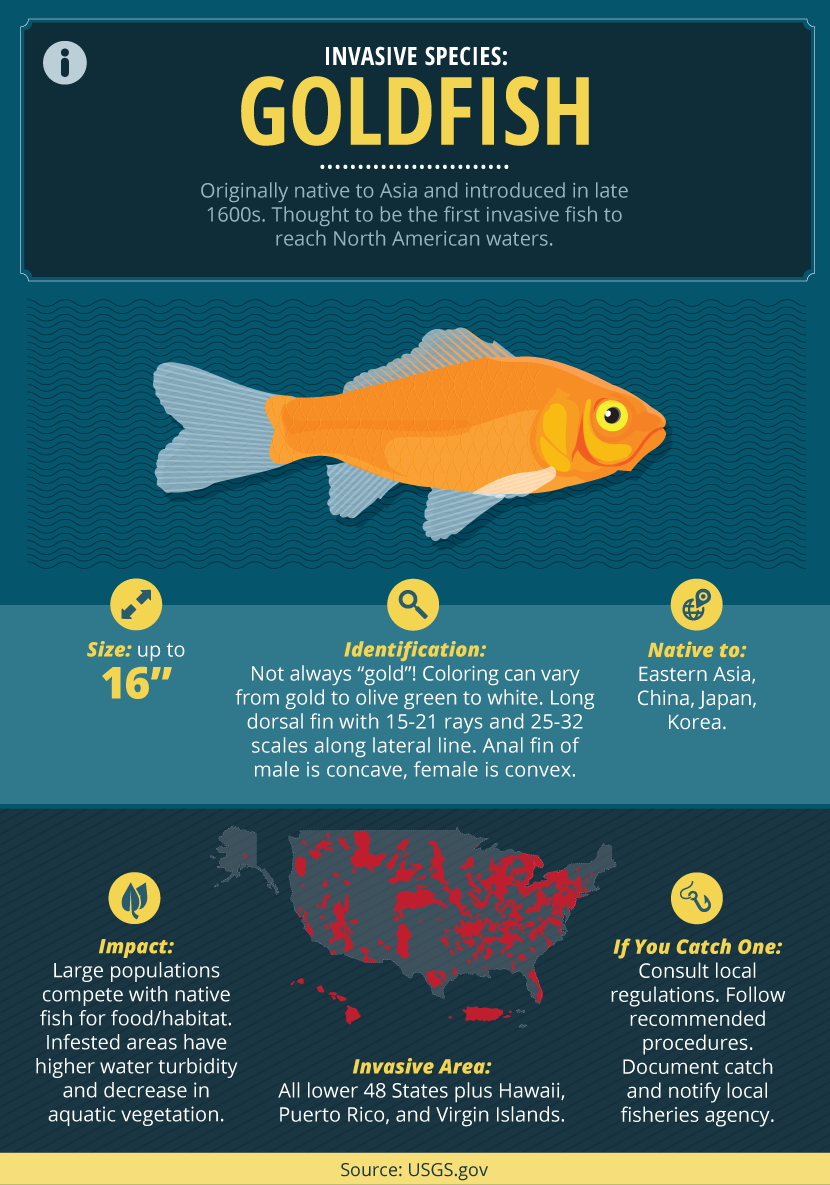
Northern Snakehead
This sharp-toothed predator is capable of living on land for up to four days, and also capable of migrating over land in its juvenile stages. The northern snakehead is highly adaptable and can thrive in a range of environments, which makes it a ferocious invasive species. Northern snakeheads look a lot like bowfin, which are native to North American waters. The easiest way to distinguish between these species is by comparing their anal fins. A bowfin’s anal fin is short, while a snakehead’s is elongated down the bottom half of its body.
Native to Russia, Korea, and China, the northern snakehead can grow to well over 15 pounds, and established breeding populations have been found in Virginia, Maryland, Pennsylvania, New York, and Arkansas. Individual snakeheads have been reported in California, Florida, Illinois, Massachusetts, North Carolina, New Jersey, and Delaware.
The full impact of this invasive species remains unknown. Adult snakeheads are highly predatory and can consume anything up to one third of their own body length! If you catch one, consult your local regulations. Due to the severity of this species’ invasiveness, some states have hotlines set up for reporting their capture. In some states, if you catch one and decide to keep it, the head needs to be immediately removed.
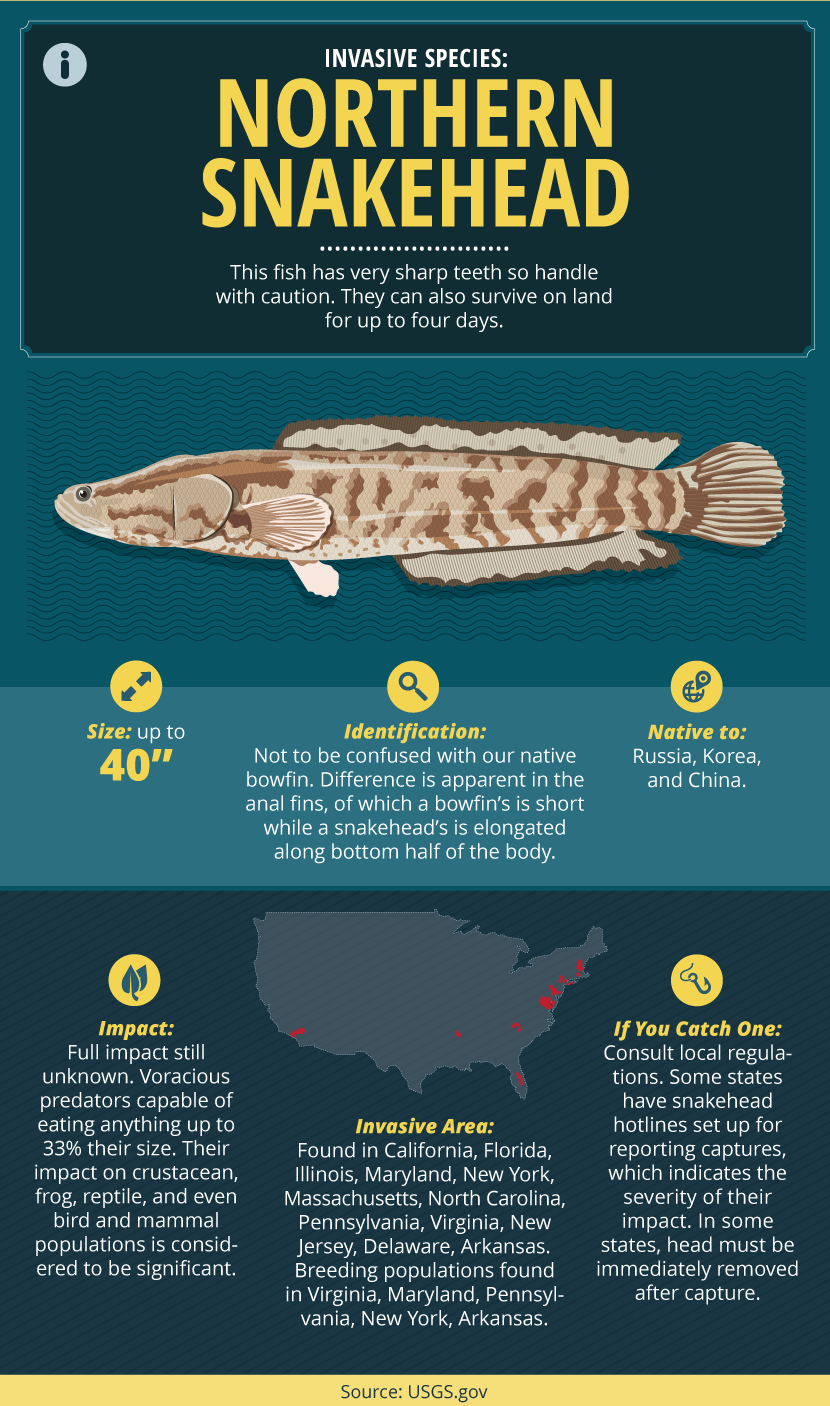
Sea Lamprey
Not to be confused with the native and non-invasive Pacific Lamprey, this parasitic feeder looks like a really, really creepy eel. It has no jawbone, two close dorsal fins, no paired fins, seven gill openings, and a large round mouth with sharp, curved teeth. In the sea lamprey’s native range it can spawn in freshwater and saltwater, and it preys on large game fish, attaching itself to them and feeding until the host dies of loss of fluid and tissues, or later from infection from the wound. Many states and agencies have specific ways set up to control lamprey populations, so consult your local fisheries agency.
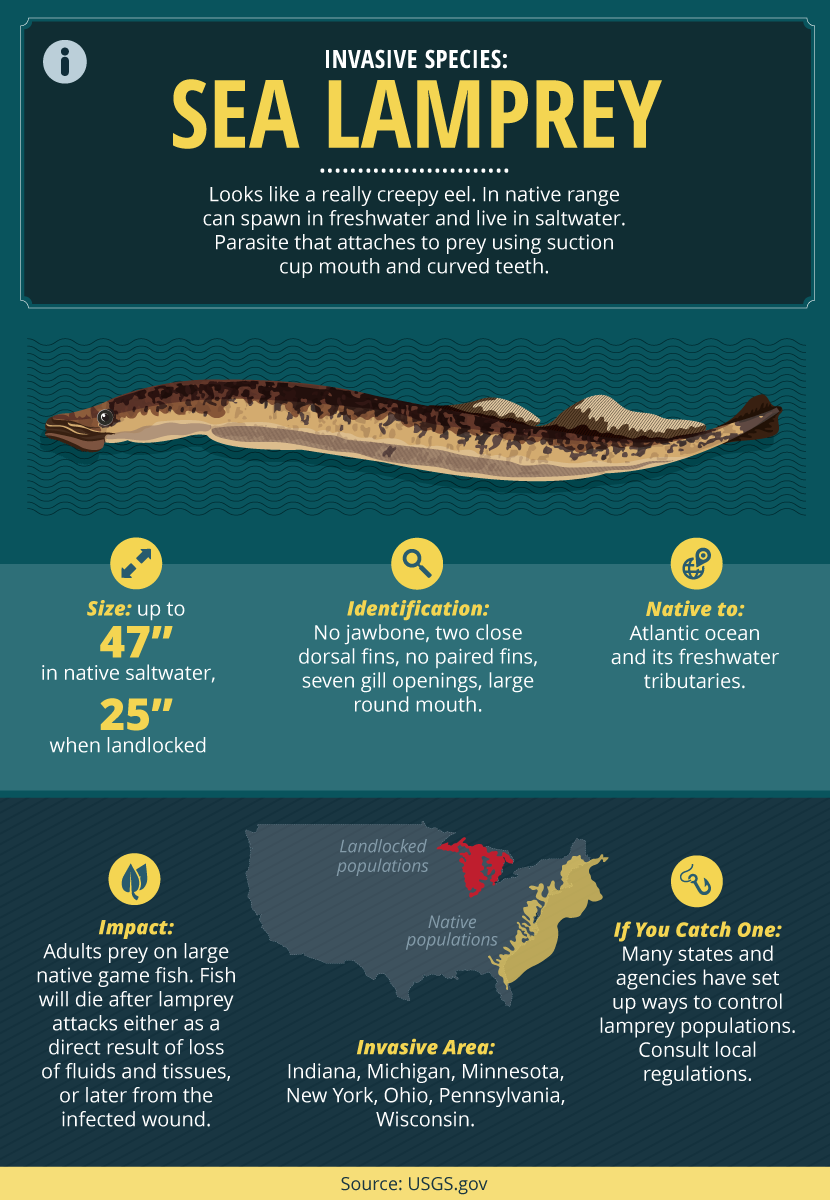
Silver Carp
Also known as the Asian carp and the “flying carp,” this species will often leap out of the water when spooked by motor boats and other loud noises. You’ve probably seen them flying through the air on YouTube videos, and wondered how the fisherman in that video got so lucky as to have fish diving into his boat! Well, the silver carp can actually be a huge hazard to boaters and anglers due to their large size and enormous populations. Some boaters have even started wearing protective helmets and padding to protect themselves from these silver missiles.
Introduced in 1973 by an Arkansas fish farmer, these carp thrive in large river systems and need very little oxygen in the water to survive. They can live for twenty years and a mature female can lay five million eggs per year. Silver carp can be identified by their very far-forward set eyes, small scales, and upturned, toothless mouths. Their average size is a whopping 30–40 pounds, and they can reach a colossal 110 pounds. If you catch one, you should (as always) consult your local regulations and report the catch to local fisheries authorities instantly if you are not in the known invasive area.
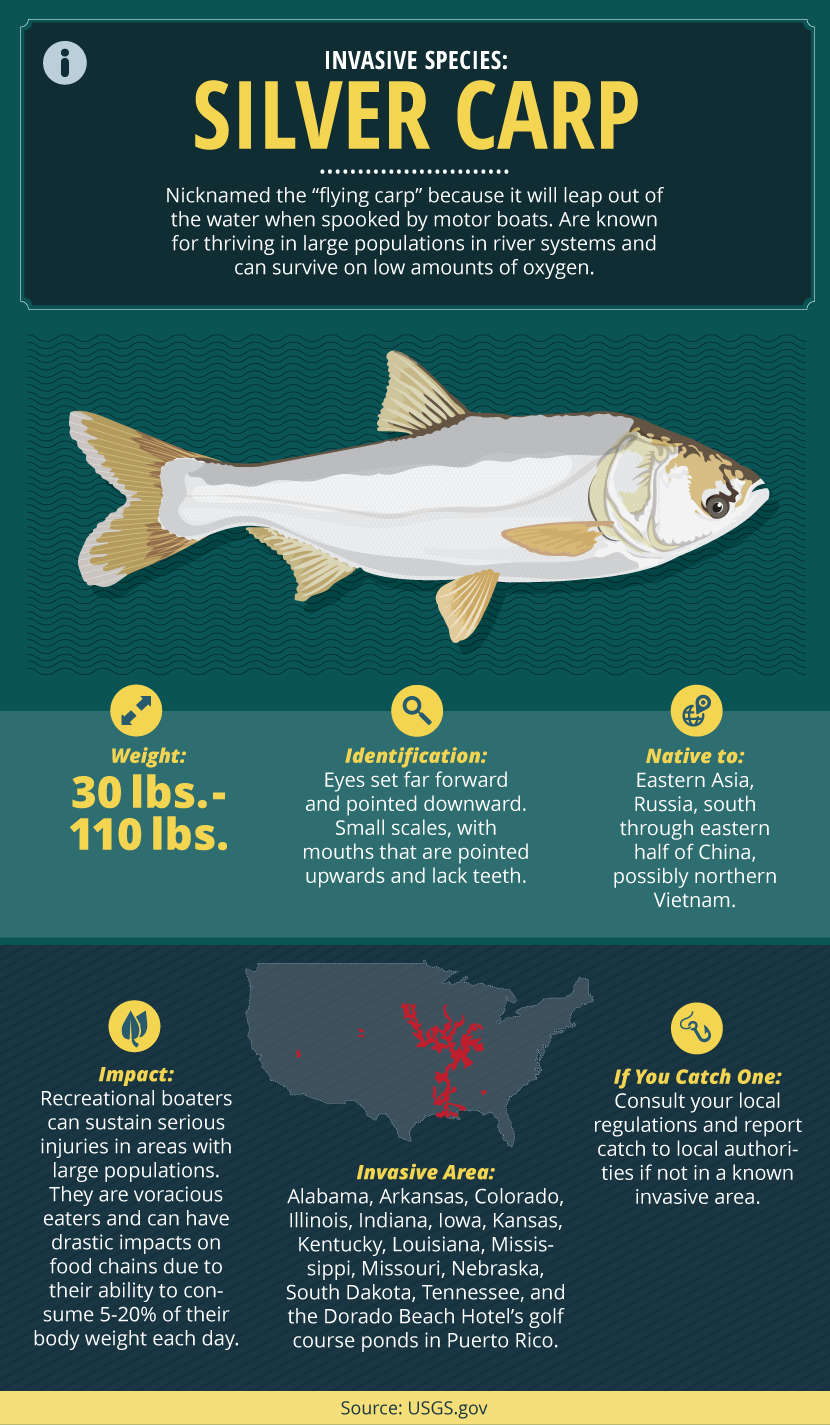
Lionfish
Technically there are two very closely related species of lionfish (Red Lionfish and Devil Firefish) that are invasive to the Gulf of Mexico and Atlantic Coast. Both are treated as the same species for the purposes of this article though, since the differences are negligible and can only be known through genetic testing. You shouldn’t have too much trouble identifying this fish. Look for greatly elongated dorsal fin spines, a white and reddish-brown striped body, and a fierce demeanor.
This venomous fish should not be taken lightly. Stings can be serious, and should be treated with hot water of around 110 degrees F for 15–20 minutes. Seek medical attention as soon as possible if stung, by calling the Aquatic Toxins Hotline at the Florida Poison Information Center in Miami, where experts will advise you immediately. The hotline is available 24/7 and can be reached at 888-232-8635.
The lionfish will not often respond to hook-and-line style fishing, with most encounters being experienced by SCUBA divers with nets and spear-fishermen, but catching one on your rod and reel is not unheard of. If you do hook one, avoid handling it at all costs. The line should be cut at the hook and if euthanizing, ensure you are able to do so without touching the fish. The fish is able to sting you even after it is dead. Note, however, that lionfish are venomous, not poisonous. Their meat is safe to consume and is actually considered to be delicious by some.
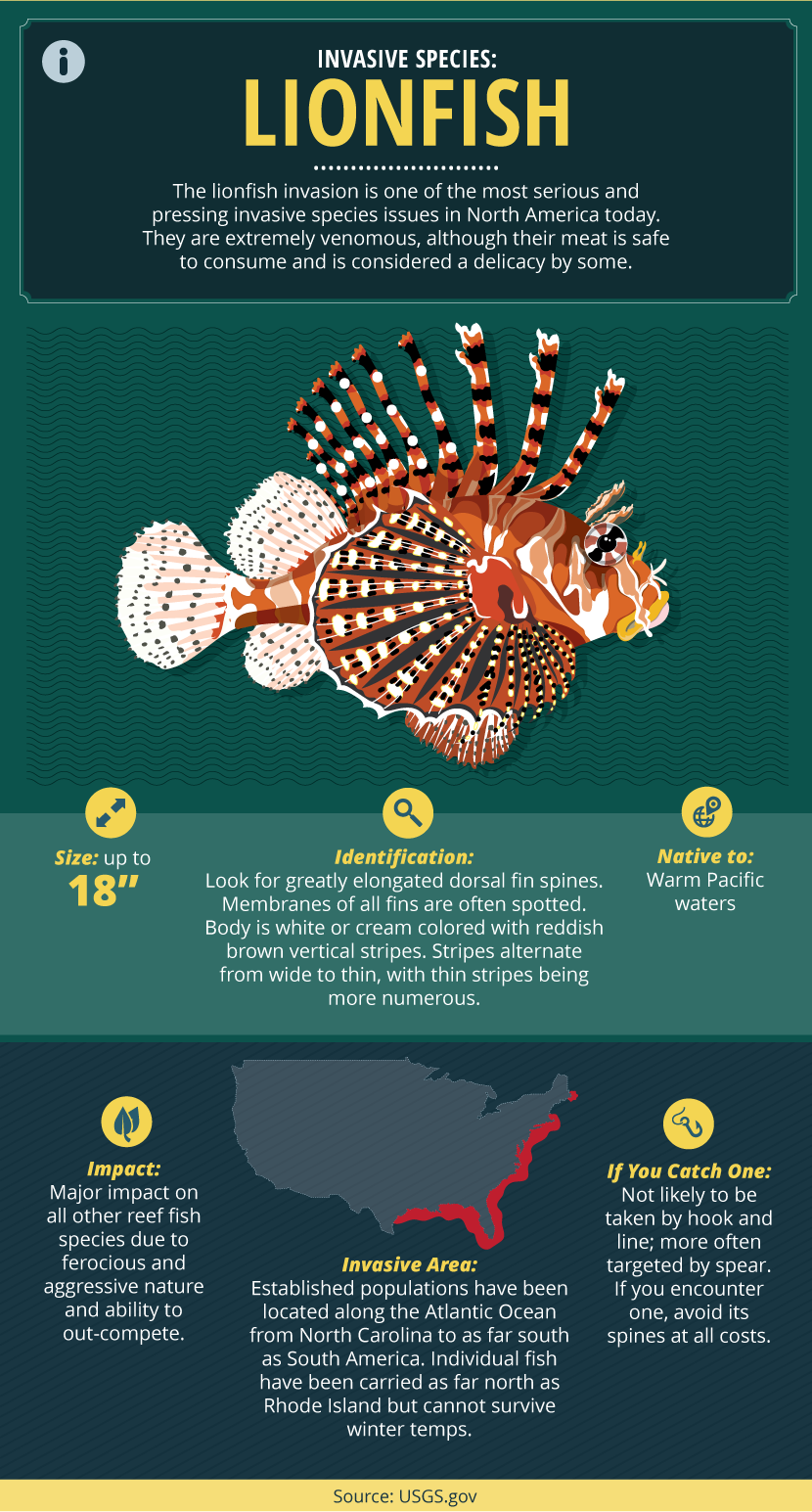
In Summary
This is by no means an exhaustive list of all the invasive species that threaten our waters. In fact, some of our favorite sport species, like bass, can be predatory and invasive in waterways they are not indigenous to, pushing out less aggressive species and out-competing them for food and habitat. You will note that a theme of this article has been that consulting local regulations is best practice, and that is for a reason. Each state’s waterways and fisheries are a delicate balance of species and environment, and thus each has its own well-established policies and definitions of what constitutes an invasive species.
Be aware of this list of five invasive fish species, but also be reminded that educating yourself about the threats to your home state from these and other invasive species is the best first step you can take to being an angler who fights on the front lines of putting a stop to invasive fish.
Fix.com wishes to acknowledge and thank the staff at the U.S. Fish and Wildlife Service for their assistance and input with this article.
Embed the article on your site

